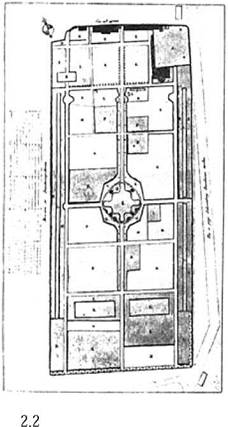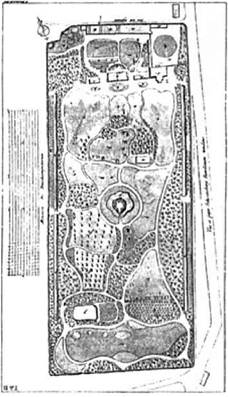On his return from South America, Alexander von Humboldt (1769-1859) wrote his Essai sur la geographic des plantes (1805)/Ideen zu einer Geographie der Pflanzen (1807). Within this he observed that there was a similarity between the vegetation within the different geographical zones at comparable latitudes around the earth and also that the flora at high altitudes on a mountain was similar to that which occurred at low altitude in the high latitudes of the arctic. Both of the latter floras had adapted to the cold and he concluded that vegetation zones around the earth were determined by temperature and rainfall, and that plants within each zone all possessed similar adaptations to the conditions (Bowler 1992:273). Deserts, seas and mountain ranges determine geographical boundaries, and Humboldt noted that the separation of Africa and South America must have taken place before the development of living organisms, as hardly a single plant of one continent was found in the other.
In 1822, the British garden author John Claudius Loudon summarised the findings by Humboldt, and acknowledged their importance, referring to ‘Botanical geography, or the knowledge of the places where the plants grow (habitationes plantarum) and the causes which influence their distribution over the globe….’ (Loudon 1822:124, 242). In his garden tours through Europe he included a visit to the botanic garden in Berlin where he observed that this ‘is one of the few gardens in which the arrangement of the plants is according to their native habitations’ (Loudon 1822:45). He however fails to make the connection with Humboldt’s writings and does not include this as an option in his planting advice for botanical gardens, until slightly later. For these he proposes ‘systematic or methodical planting’, which is concerned with contemporary scientific classification according to the system of Jussieu or Linnaeus ‘as a foundation, and combining at the same time a due attention to gradation of heights’, which shows a concern for contemporary aesthetic tradition (Loudon 1822:915, 1191).
The botanist Karl Ludwig Willdenow first inspired Humboldt in botany in 1788 (Kelner 1963:91), and has therefore been referred to as the ‘grandfather of botanical geography’ (Hyams and MacQuitty 1969). As Professor Willdenow he took over the botanic garden in Berlin in 1801, after a period of neglect, and converted this into a flourishing institution (Wendland 1979:186). Through mediation by Alexander von Humboldt, he was able in 1807 to obtain an additional grant for maintenance via the French administrator whilst retaining the existing allowance from the Academy. By the time of his death in 1812, the garden had substantially altered (Figures 2.2 and 2.3), and his gardener, Friedrich Otto, continued the improvements, later with Professor Heinrich Friedrich Link who was appointed to replace Willdenow in 1815 (Loudon 1822:45). The Berlin botanic garden differed from others in that it no longer contained any order beds, the classical feature for systematic or methodological planting as found in other botanical gardens. Willdenow established this through his friendship with Humboldt, with the garden displaying features of the ‘landscape’ style, but details as to the exact arrangement and groupings are not known. Humboldt later acknowledged that the path of his entire career had been due to the Berlin botanic garden, which implanted in his mind ‘the seeds of an irresistible desire to undertake distant travels’.2
Whilst this landscape style became fashionable in botanical gardens elsewhere shortly afterwards, as for example Loudon with the Birmingham Botanical Garden (1831, which still contained areas of order beds), and the Derby Arboretum (1839), and Robert Marnock at the Sheffield Botanic Garden (1834), the arrangement followed aesthetic rather than scientific, phytogeographical principles. In 1835, Loudon had first promoted the idea of ‘scientific gardens’ in his famous essay ‘On the laying out public gardens and promenades’. A total of 12 categories of scientific gardens are included, including ‘Zoological’, ‘Botanical’, ‘Horticultural’ and ‘Agricultural Gardens’, ‘Arboretums’, Herbacetums’, ‘Plantariums’, but also ‘British Floras, or gardens of British Plants…’, ‘LocalFloras, or assemblages of the plants of the neighbourhood, district or province.’, ‘Geographical Gardens, in which plants, either hardy or exotic, or both, are arranged according to their native countries’, and ‘Geological
|
|
Survey of the Berlin botanical garden in 1801—prior to alterations by Carl Ludwig Willdenow (Heinrich Friedrich Link Hortus regius botanicus berolinensis (1827)
|
|
2.3
Survey of the Berlin botanical garden in 1812—indicates the changes of the intervening years, when orderbeds were removed and the layout was modified in a more naturalistic landscape style layout (Heinrich Friedrich Link Hortus regius botanicus berolinensis (1827)
Gardens, in which hardy plants are arranged according to the soils in which they thrive best’. A garden of plants that are natives of the British Isles had to be ‘both interesting and instructive’, and Loudon suggested a number of possibilities of arrangement, ‘either methodical, geographical, geological, or topographical’. Topographical meant the ‘placing of plants of each county in a group by themselves’. This varied from a Local Flora, i. e. ‘a collection of the plants indigenous to a particular locality’ only in the extent (Loudon 1835).
Similar ideas had been mooted a few years earlier by Joseph Paxton, the head gardener to the Duke of Devonshire at Chatsworth, who had promoted a new national garden, a zoological garden arranged according to the different quarters of the globe. He suggested that quarters might again be divided in the different states located in them ‘and thus, in connexion with Zoology and Botany, would be given practical acquaintance with Geography’. The plants were proposed to be planted according to the ‘Natural Arrangement’ within these, i. e. presumably planted according to the Linnaean system (Paxton 1831).
The first landscape designer who appears to have published the relevance of Humboldt’s discoveries as part of a coherent theory was Gustav Meyer in his Lehrbuch der schonen Gartenkunst (i860), which acknowledges Humboldt’s influence (Meyer 1860:163) and includes lists of plants arranged according to their native countries, habitats and soil conditions (Meyer 1860:171-177). In this he also includes the term ‘plant physiognomy’ for which he quotes from Humboldt and Zollinger, and he lists the main plant shapes relating to adaptation to different environmental conditions (Meyer 1860:158). Meyer thus incorporated his ideas in his proposals, including the design of the (and his) third public park in Berlin, the Humboldthain, founded to memorise the hundredth anniversary of the birthday of Humboldt in 1869. This park included an area for cultivation of plants and education, and a small area for botanical education. The planting of the larger area of the park was noted for a scientific approach, which ‘not only included all our native woody plants, but also those from other countries, especially North America and Siberia, which without protection resist our climate and can be recommended for their beauty’. There was substantial planting of allees, including one with various exotics, which enabled landowners to increase their knowledge in selecting appropriate trees for their properties. Meyer also ‘composed plant geographical groups which provided a notion of the vegetation and physiognomy of other countries’.3
Meyer was not the only landscape designer to be influenced by Humboldt’s treatises; from 1857-1860 Eduard Petzold executed an arboretum at Muskau, which was arranged both scientifically and artistically, and incorporated a geographical section where the woody plants were arranged according to their countries of origin (Schmidt 1984). Humboldt’s influence was not restricted to Germany, however, as several of his books were translated. The American landscape gardener Andrew Jackson Downing showed an awareness of Humboldt’s writings, quoting from Cosmos in an 1849 essay entitled ‘The philosophy of rural life’. Here he compared the differences in approach between the people of north and south Europe, and Humboldt was recognised to be the ‘only writer who has ever attempted to account for this striking distinction of national taste of gardening…’. Appealing presumably to an audience of north European emigres, he quoted that ‘certain races of mankind are. deficient in their perception of natural beauty; that northern nations possess the love of nature much more than those in the south.’ (Downing 1853:102).4




